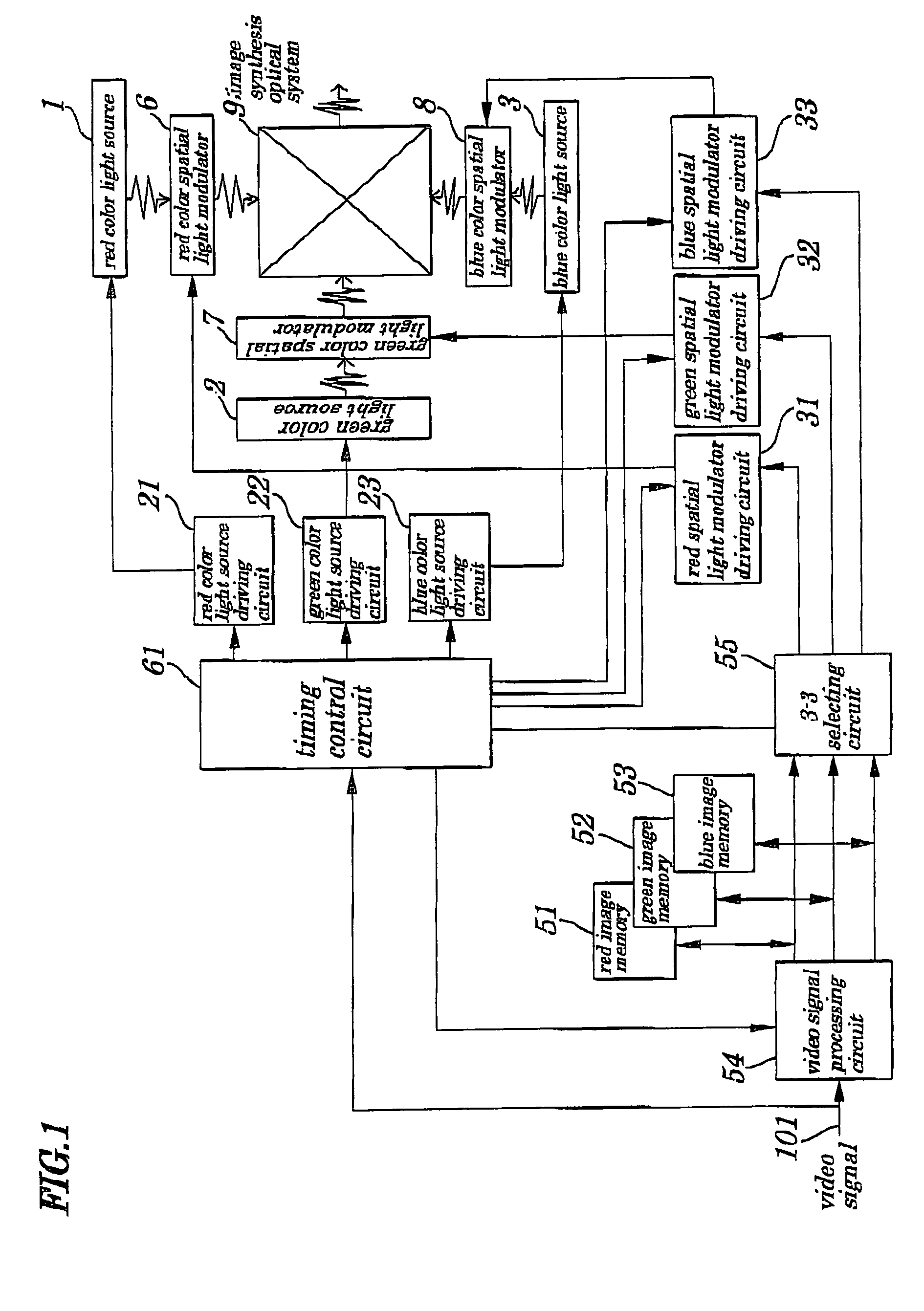Video display device with spatial light modulator
a technology of video display device and light modulator, which is applied in the direction of picture reproducers using projection devices, static indicating devices, instruments, etc., can solve the problems of difficult to see clearly, and difficult to correct the color reproductivity of a color having high excitation purity, etc., to enhance the brightness of an image, improve the effect of color reproductivity and avoid complicated circuits
- Summary
- Abstract
- Description
- Claims
- Application Information
AI Technical Summary
Benefits of technology
Problems solved by technology
Method used
Image
Examples
first embodiment
[0111]FIG. 1 is a schematic block diagram showing configurations of a video display device according to a first embodiment of the present invention. FIG. 2 is a timing chart showing a method for controlling a light source for each color employed in the video display device of the first embodiment. FIG. 3 is also a timing chart showing another method for controlling the light source for each color employed in the video display device of the first embodiment.
[0112]The video display device of the first embodiment, as shown in FIG. 1, chiefly includes a red color light source 1, a green color light source 2, a blue color light source 3, a red color spatial light modulator 6, a green color spatial light modulator 7, a blue color spatial light modulator 8, an image synthesis optical system 9, a red color light source driving circuit 21, a green color light source driving circuit 22, a blue color light source driving circuit 23, a red spatial light modulator driving circuit 31, a green spa...
second embodiment
[0158]FIG. 4 is a schematic block diagram showing configurations of a color-sequence-type video display device according to a second embodiment of the present invention. FIG. 5 is a timing chart showing a method for controlling a light source for each color employed in the color-sequence-type video display device of the second embodiment. FIG. 6 is a timing chart showing another method for controlling the light source for each color employed in the color-sequence-type video display device of the second embodiment. FIG. 7 is a timing chart showing still another method for controlling the light source for each color employed in the color-sequence-type video display device of the second embodiment. FIG. 8 is a diagram showing one example of a color triangle on a chromaticity diagram in the CIE 1931 standard colorimetric system.
[0159]The color-sequence-type video display device of the second embodiment, as shown in FIG. 4, chiefly includes a light source section 10, a red color light so...
third embodiment
[0189]FIG. 9 is a schematic block diagram showing configurations of a color-sequence-type video display device according to a third embodiment of the present invention. FIG. 10 is a timing chart showing a method for controlling a light source for each color in the color-sequence-type video display device according to the third embodiment. The color-sequence-type video display device of the third embodiment, as shown in FIG. 9, chiefly includes a light source section 10A, a red color light source driving circuit 21, a green color light source driving circuit 22, a blue color light source driving circuit 23, a white color light source driving circuit 24, a spatial light modulator 30, a spatial light modulator driving circuit 41, a red image memory 51, a green image memory 52, a blue image memory 53, a video signal processing circuit 54, a 3-1 selecting circuit (RGB simultaneously selecting circuit) 56, and a timing control circuit 63. Moreover, the light source section 10A is made up ...
PUM
 Login to View More
Login to View More Abstract
Description
Claims
Application Information
 Login to View More
Login to View More - R&D
- Intellectual Property
- Life Sciences
- Materials
- Tech Scout
- Unparalleled Data Quality
- Higher Quality Content
- 60% Fewer Hallucinations
Browse by: Latest US Patents, China's latest patents, Technical Efficacy Thesaurus, Application Domain, Technology Topic, Popular Technical Reports.
© 2025 PatSnap. All rights reserved.Legal|Privacy policy|Modern Slavery Act Transparency Statement|Sitemap|About US| Contact US: help@patsnap.com



